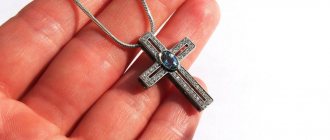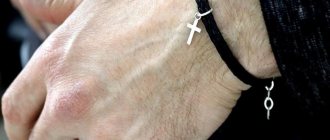1:502 1:507
The cross is an indicator of belonging to the Christian faith. From this article you will find out whether it is possible to wear someone else’s cross, and why it cannot be worn over clothes.
1:800
The cross, according to the clergy, should always be on a believer. But there are also prohibitions associated with it. Some of them are nothing more than superstitions that a believer should not even think about. These include, for example, the darkening of the cross. But this is far from the only question that a believer may have about his cross.
1:1487 1:1492 1:1552
2:503 2:508
You cannot wear an unconsecrated cross
It is best to consecrate the cross. But as such, there is no prohibition on wearing an unconsecrated cross. It is believed that evil spirits avoid even two crossed sticks. Nevertheless, a believer should still consecrate his symbol of faith. You can choose any cross you like: gold, silver, copper or wood. The material is not very important. It is important to consecrate it and not wear jewelry purchased at a jewelry store as a cross. It is necessary to understand that the church Orthodox cross, which symbolizes faith in God, differs from beautiful, but purely decorative crosses. They do not carry a spiritual load and have nothing to do with faith.
2:1323 2:1328 2:1398
3:1902 3:4
Why should I go to church if I have faith in my soul? Why wear a cross if I’m already a Christian? Is it really written in the Gospel that everyone should wear crosses? So to wear or not to wear? Similar questions are often asked by unchurched people.
3:464
Let's try to answer.
3:505 3:510
Loss of the pectoral cross
Priest Mikhail Vorobyov, like all ministers of the Orthodox Church, does not see anything terrible in the loss of a pectoral cross, except for the accident and absent-mindedness of the loser. Having allowed such a situation, you should simply purchase a new cross, and if the purchase is made in a store and not in a temple, then you should definitely consecrate it.
Those Christians who, in such a case, begin to believe in negative superstitious interpretations, according to Deacon Konstantin Gorbunov, demonstrate insufficient faith in God, a departure from true knowledge of God and faithful participation in church life.
Where did this tradition come from?
Wearing a cross without a real Christian life will look like some kind of fake. Treating the cross as a beautiful decoration will also serve to condemn a person. So what happens: you can’t wear it, otherwise you’ll harm yourself?
3:1016
Wearing a pectoral cross is not only possible, but also necessary. Many believers can confirm: this is the most powerful protection for a person. Why? Because the cross is the instrument of Christ's death. The crucified Jesus washed away the sins of every person with His Blood.
3:1440
Therefore, this reminds every Christian of the sacrifices God makes for man, for which Christ suffered. If Jesus had not suffered, the people would have had no hope of salvation. The cross is rightly called the instrument of our salvation. But many people refuse to wear this item on their body.
3:1985
Among the arguments, the most popular are:
3:77
- this in no way confirms that I am a Christian;
- There are no indications in the Gospel about wearing a cross; the first Christians did not know this either...
Yes, indeed, wearing a cross on a pectoral cross without practicing Christian life is reminiscent of a person trying to sail on a wreck of a ship in a storm.
3:603
Indeed, the Gospel and the lives of the early Christians do not indicate that people supported modern practices.
3:809
But in the life of the early church there was a custom of wearing medallions with the image of the slain Lamb or the Crucifixion. Sources from the 2nd century indicate: some Christians already had crosses or painted them on their foreheads in order to “give themselves away” to their persecutors and suffer for their faith. When the “hunt” for believers subsided, the pious example of the early Christians spread widely.
3:1446
An interesting historical fact is given by Archpriest Igor Fomin.
3:1564
There was one rather humiliating custom in the Roman Empire. Just as we now put a collar on dogs, their slaves wore the same straps around their necks indicating the name of their owner.
3:324
The first Christians, opposing themselves to such a society, wore crosses, as if saying: we do not belong to you. We have another Master who paid for us with his own life.
3:676 3:681
What an Orthodox cross should look like
So, an Orthodox pectoral cross should look like... Wait, it shouldn’t do anything: it’s a material symbol of faith that can take different forms. Yes, there are some canons, but they are so vague and conditional that it is almost impossible to make a mistake when choosing an Orthodox creed!
Church ministers are increasingly refusing to consecrate crosses due to non-compliance with the canons. The most advanced priests even consecrate crosses with Latin inscriptions and other signs of Catholic origin.
Contrary to popular misconception, the Orthodox Church recognizes crosses in a variety of shapes:
- Four-pointed. These simple crosses, consisting of just two crossed crossbars, are often called Latin crosses. Many people clearly consider them Catholic. This is incorrect: the Orthodox Church is not so categorical on this issue, especially since the baptist of Rus', Prince Vladimir, owned exactly such a cross. And one more thing: you can wear an Orthodox cross without a crucifix, inscriptions and other symbolic elements. Just a smooth four-pointed cross is enough!
View all gold “Cross” pendants in the SUNLIGHT catalog
- Six-pointed. In such crosses, another bar is added - an inclined lower one. There are different interpretations of its meaning: according to various sources, it symbolizes the internal balance of a person, his path to spirituality, or the scales on which human sins and blessings are weighed.
- Eight-pointed. These are canonical Orthodox crosses. Compared to six-pointed ones, they have an additional upper bar of shorter length than the main transverse one. It is called a title and serves as a symbol of a tablet that was once nailed over the head of the crucified Lord. According to the Orthodox tradition, the letters IHCI are inscribed on it, which, when deciphered from the Church Slavonic abbreviation, gives the phrase “Jesus of Nazareth, King of the Jews.” Since the time of Ivan the Terrible, this cross has been decorating the domes of churches, it is placed on the graves of parishioners of the Russian Orthodox Church, and is used in state symbols.
The eight-pointed cross is one of the oldest symbols of the Christian religion. It was widely used back in VI, when there were no Catholics, Orthodox, Uniates, Protestants and others like them, but there were simply Christians, united in the faith.
The canonical Orthodox cross with the crucifixion of Jesus Christ is visually somewhat different from the Catholic one. Let's go over the main differences:
- Figure of Christ. In the Orthodox tradition, the crucifix is more optimistic and life-affirming. Christ is depicted as already risen, with open arms and a spiritual look. The Catholic Savior is as if caught in the stage of agony or already dead: he hangs helplessly on the cross, clearly suffering.
- Nuances. On Catholic crucifixes there is often a crown of thorns on the head of Christ; in Orthodoxy it is usually absent. And the most important thing, on which many theological copies were broken - the feet of Christ. In the Orthodox tradition, the Savior receives a nail per foot (four in total), according to the Catholic tradition - one nail for both feet. Sometimes Orthodox priests refuse to consecrate crosses, guided by this very sign. Does the fact that Jesus is nailed with three nails make him no longer the Savior of mankind?
- Inscriptions. We have already talked about one inscription (it flaunts on the title, that is, the upper crossbar, or simply at the top of the cross) - Church Slavonic IHCI or Russian INCI. On the Catholic cross, a similar abbreviation is written in Latin INRI. On both crosses there may be all sorts of additional symbols and decorative elements, but only on the Orthodox cross on the reverse side is written: “Save and Preserve.”
There are many less common varieties of the Christian symbol. For example, the monastic cross-Golgotha, complemented by steps, a skull and other symbols, crosses with wedge-shaped petals topped with lilies or drops.
Spiritual protection
4:1221 4:1226
Today it is customary to put a cross on a person after performing the Sacrament of Baptism. This is a confirmation of my involvement in the Church and the understanding that the Son of God suffered for my sake.
4:1548 4:4
- Yes, all this is nonsense! Why wear a cross? - the skeptic will say. — Just think: two wooden sticks or a metal figurine. Can they protect a person?
4:290
The answer is very laconic: they can. A lot of evidence can be found.
4:407
For example, during difficult Soviet times, it was forbidden to wear “metal figures.” If a girl is going to marry a man of other faiths, she is usually required to remove... her cross. It goes something like this: renounce your faith, turn away from Christ.
4:856
And how many stories there are about how, without a cross, people were deprived of spiritual protection! Many became possessed - they were possessed by evil spirits. And when someone approached them with a cross, they began to cower, scream, curse, and bang their heads against the wall...
4:1326 4:1331
History of the pectoral cross
In the 4th century in Jerusalem, the miraculous discovery of the Holy Cross by the holy Queen Helen took place. Then widespread veneration of this blessed symbol began, including through wearing it on the body. Later, crosses began to depict the crucified Lord. In the Middle Ages, He was often represented in a different form - blessing or sitting on a throne.
In Rus', the first pectoral crosses appeared in the middle of the 10th century, even before the official adoption of Christianity (988). They were worn by individual Christians who converted to Orthodoxy earlier than other compatriots, “on their own initiative.” After the Baptism of Rus', crosses were worn for some time on top of clothes to publicly declare their faith. Later it became customary to hide the shrine from prying eyes. After all, true faith is manifested not by external attributes, but by life and deeds. Protodeacon Sergius Shalberov, speaking about whether it is necessary to wear a cross, notes:
“Wearing a cross is, first of all, a manifestation of personal piety. But historically it turned out that this custom became familiar and became the norm of Christian life. And the absence of a cross began to be regarded as a sin and a departure from the faith.”
During periods of atheistic persecution, many Christians suffered and became holy martyrs for refusing to take off their cross and renounce Christ. The Slavs had a pious custom of exchanging personal crosses as a sign of brotherly love and fidelity.
Question: When should you be baptized?
— You should sign yourself with the sign of the cross at the beginning of prayer, during prayer and after its end, as well as when approaching everything holy: when entering a temple, when applying it to the cross, icons, and holy relics. One must be baptized in all important situations in life: in danger, in grief, in joy, before starting any task and after its completion, before and after eating, before leaving the house and when entering the house, and in many other situations.
All the Divine Sacraments are sanctified by the sign of the cross, and every thing necessary for life is sanctified by it.
Question: Is it possible to wear a cross and a zodiac sign on the same chain?
— We need to decide: either a person believes in God and wears a cross after Baptism, or prefers superstitions and “amulets.”
The cross that believers wear is not a decoration or a “talisman”, but a testimony of fidelity to the Holy and Life-Giving Cross of the Lord. The Cross protects because the Lord Himself protects those who believe in Him: “Protect me, Lord, by the power of Your Honest and Life-giving Cross and save me from all evil.” And most people wear “amulets”, zodiac signs and other amulets out of superstition.
The cross is a symbol of distinction
However, it was the cross that became the triumph of life over death, a symbol of a new era, a new hope. This is indicated by the Christian writer Pontius, author of the biography of St. Cyprian of Carthage. He writes that some especially zealous Christians in the 2nd and 3rd centuries, in order to endure suffering for Christ, depicted a cross on their foreheads so that the pagans would recognize them and hand them over to torture.
They began to wear a pectoral cross at the beginning of the 4th century: for example, the holy martyrs Orestes and Procopius did this - their crosses were made of eternal metals - gold and silver.
After the miraculous appearance of the cross in the sky, which appeared before the battle of the Great Emperor Constantine with Maxentius, even the pagans learned what exactly this cross signified - from now on it was a symbol of the victory of Christ over the devil. And the erection of the Cross of the Lord in Jerusalem by Empress Helena only confirmed its power, which even death could not resist.
After Constantine declared Orthodoxy the state religion, many residents of Byzantium began to wear similar symbols of Christianity.
The canonical image of the cross was approved at the Council of Trull in 692, which decided that the image of Christ should breathe greatness and remind not only of suffering, but also of His victory over death.
What to do with someone’s lost cross and is it possible to pick it up from the ground?
The church ministers are unanimous in their opinion on this issue; the found cross must be picked up, since this is God’s providence. God gave the person who found it a happy opportunity to save the shrine from desecration and trampling in the mud. Raising the cross is a just and godly deed.
The found cross must be carefully lifted from the ground with respect and humility, prayer, and used at your own discretion. You can wear it yourself, consecrating it in church, you can give it to a person in need of a cross, or you can simply bring it to church and leave it there.
But under no circumstances should you step over the cross and leave it for further abuse - to wallow in the dirt.
There is a belief that by putting someone else’s cross around his neck, a person takes upon himself the fate and sins of the previous owner. The Church condemns such superstitions, because a shrine is not a chest in which savings are folded, and our Lord gives everyone his own destiny, the one and only, the one that we are capable of and each of us bears his own cross.










